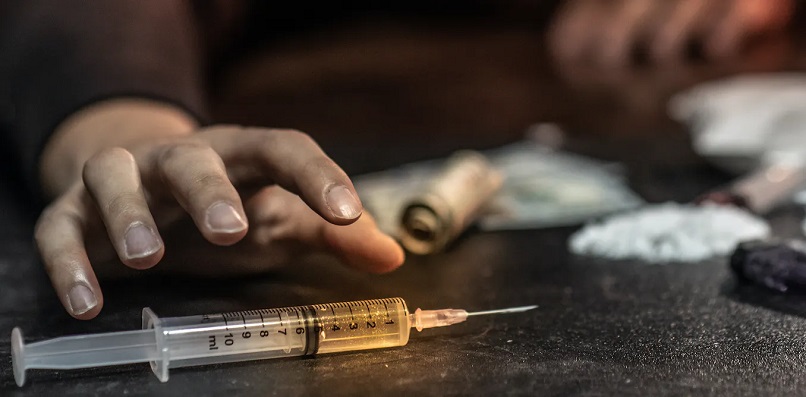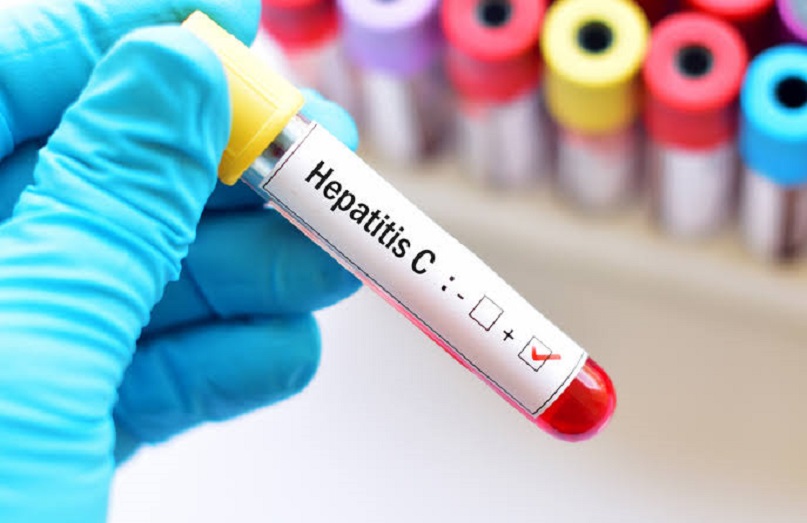
As the sun cast its golden hues upon the world outside, the bright white corridors of the Shri Maharaja Hari Singh (SMHS) hospital’s drug de-addiction center presented an atmosphere of unsettling calm. The usual bustling activity had subsided, leaving behind a hushed ambiance occasionally punctuated by the anxious steps of a young boy.
Irfan (name changed) had been admitted to the facility just three days prior, but to him, it felt like an eternity. The deep, dark circles under his sunken eyes contrasted sharply with his pale face, as if carrying the weight of regret and hopelessness. At just 23 years old, he had endured a tumultuous path paved with poor choices, tempting distractions, and an unrelenting desire for escape. His journey into drugs, like that of many others, commenced as a reckless experiment among friends. What began as an attempt to fit in gradually spiraled into a full-fledged addiction. “It all started with weed,” he recounted, his voice filled with regret. “Alcohol, brown sugar, and other substances followed. Eventually, injecting heroin became the answer to my insatiable craving,” he added.
After five tumultuous years, the tragic deaths of four close friends within three months and mounting familial pressure compelled Irfan to confront his addiction and seek treatment. But, despite this decision to turn to sobriety, he has another enemy to fight – Hepatitis C. “We didn’t always have access to clean needles, and many times we resorted to sharing insulin pens for injecting heroin directly into their veins. I was always aware of the risks of needle-sharing, including Hepatitis, but amidst the grips of addiction, the warnings always felt distant,” he confided, his voice laden with worry.”I knew I had contracted HCV. It was present there in the circle and nearly 200 boys I know have Hepatitis.”
Akin to Irfan, another young boy’s struggle with substance use disorder had led him down a dark and perilous path. He was unaware of the toll it was taking on his body and the hidden dangers lurking within his bloodstream. Eventually, when he hit his rock bottom, he decided to confront his demons and seek help at a local rehabilitation center in south Kashmir. As part of the intake process, he underwent a thorough medical examination, including tests for various infectious diseases. To his surprise, the results revealed that he had tested positive for hepatitis C, a silent intruder he never knew had invaded his body.
“I had been experiencing fatigue, persistent abdominal pain, and a loss of appetite for months, but I always believed that they were merely the fallout of my drug use,” the boy said. “Now, it has badly infected my liver,” he lamented.
The plight of these boys mirrored that of countless individuals trapped in the vicious cycle of addiction. Substance abuse has seen a drastic surge in recent years with Kashmir bearing the burden of approximately a million drug addicts. Shockingly, a recent study shows that drug abuse in Kashmir has surpassed that of Punjab, earning the region second position on the all-India list of states grappling with rampant substance abuse.

The use of intravenous opioids, mainly heroin, is leading to a spike in Hepatitis C cases in Jammu and Kashmir. Hepatitis C is a contagious, bloodborne disease that causes inflammation of the liver. The virus can cause both acute and chronic hepatitis, ranging in severity from a mild illness to a serious, lifelong illness including liver cirrhosis and cancer. One of the most prevalent modes of transmission is through the sharing of needles that are used for injecting drugs with individuals who are already infected with the virus.
“This is an epidemic,” says Dr. Yasir Rather, an addiction psychiatrist at Institute of Mental Health and Neurosciences (IMHANS) in Srinagar. “We routinely screen all our patients for different infections, and it has been found that approximately 70% of drug users test positive for HCV. Injecting drugs is becoming increasingly common in Kashmir and this group is more vulnerable to acquiring Hepatitis C because of their high-risk behaviors like needle sharing,” he told Kashmir Observer.
IMHANS, a prominent rehabilitation facility, witnesses a constant influx of drug addiction cases, with heroin abuse accounting for a significant majority. Official data reveals that the Institute receives a staggering number of 150 drug addiction cases per day, encompassing both new admissions and follow-up visits. The sheer volume of syringes, over 33 thousand in number, used daily for heroin injections exemplifies the terrifying reality.
“Unlike HCV, Kashmir has a low prevalence of HIV among drug users. There are several factors that contribute to this situation, and one of them can be that HIV has not entered the chain of transmission in a significant way within the drug using population.” Dr Yasir said.
A study conducted by IMHANS titled, ‘Seroprevalence of HIV, Hepatitis B and Hepatitis C; the associated psychiatric co morbidities and stigma among injection drug users in Kashmir: A Hospital-Based, Cross-Sectional Study’, found the prevalence of Hepatitis C among drug abusers in Kashmir to be 72 percent.
Lecturer psychiatric social worker, Government Medical College, Srinagar, Mohammad Sameer Khan, also said a significant observation has been made regarding drug addicts who tend to use drugs in pairs. In many instances, they either reuse needles or share them, particularly in secluded areas where access to clean equipment, such as distilled water, is limited.
According to various reports, it is estimated that each injecting drug user (IDU) who is infected with hepatitis C can potentially transmit the virus to about 21 other individuals. Many individuals may remain unaware of their infection for weeks, months, or even years. This increases the likelihood of sharing the drug equipment with an infected person, facilitating the further spread of the virus. Unlike Hepatitis A and Hepatitis B, there is currently no available vaccine that provides protection against Hepatitis C. However, there are antiviral medications that are used to help clear the infection from the body and prevent it from progressing into a chronic condition.
Continued risky behaviors and preventive strategies
Relapses often involve a return to drug use and engagement in risky behaviors such as sharing needles and these behaviors significantly increase the likelihood of Hepatitis C transmission. Individuals who relapse may find it difficult to resist the temptation of using drugs and might revert to unsafe practices, perpetuating the spread of Hepatitis C.
Dr. Yasir also opined that opioid dependence is now widely recognized as a chronic brain illness, where individuals often experience recurrent relapses even after periods of remission from drug addiction. So, in order to address the issue of illicit drug use and prevent infections such as HIV and Hepatitis C, health professionals at addiction treatment facilities across the Union territory employ a harm reduction strategy called Opioid Substitution Therapy (OST). OST involves replacing or substituting the use of illicit opioids with prescribed medications under strict supervision of de-addiction experts, providing individuals with a safer and controlled alternative.
The addiction psychiatrist explained that in order to address the cravings and withdrawal symptoms experienced by drug addicts, medically prescribed drugs such as Buprenorphine and Methadone are administered during Opioid Substitution Therapy (OST). These prescribed medications have been proven to be safe, legal, and have a sustained and ceiling effect, meaning that their effectiveness plateaus at a certain dosage, reducing the risk of overdose. “OST not only helps in reducing complications and secondary harms like HCV but also improves patient retention in treatment programs. The opioid medicines used for OST are available free of cost at government centers or hospitals, ensuring accessibility for individuals seeking treatment,” he said. “The primary goal of this therapy is to eliminate the need for continued drug administration and enable injecting drug users (IDUs) to cease their injecting behavior.”
“The inconsistent behavior among drug users can negatively impact their adherence to treatment and worsen the overall consequences of Hepatitis C. So, incorporating psychological interventions alongside treatment are crucial for reducing the risks,” Dr. Umar, who works at a drug addiction centre in south Kashmir, said.
He said that OST not only addresses the physical aspects of opioid dependence but also plays a vital role in destigmatizing the experiences of individuals who inject drugs. “In society, people engaged in illicit drug use are often stigmatized and viewed as criminals or anti-social individuals. However, when receiving OST within clinic settings, they are recognized as patients and victims of a chronic brain illness,” the doctor said adding that this shift in perception from criminality to a healthcare approach is crucial in reducing the societal stigma surrounding drug users.
Steps to be taken to reduce the risk of hepatitis C transmission when drug abuse is common:
Education and Awareness: Provide education and awareness programs to individuals involved in drug use. Inform them about the risks of hepatitis C transmission through needle-sharing and the importance of prevention.
Testing and Counseling: Offer regular hepatitis C testing and counseling services to individuals who use drugs.
Treatment for Substance Use Disorders: Promote access to substance abuse treatment and rehabilitation services.
Supportive Services: Provide access to social services, housing, and mental health support to address the underlying issues contributing to drug addiction.
Legal Reforms: Advocate for drug policy reforms that prioritise harm reduction and public health approaches over punitive measures.
Community Outreach: Engage with community groups and outreach workers who can establish trust with individuals involved in drug use and connect them with necessary services.
Vaccination: Hepatitis C can be prevented by vaccination in some cases, but currently, there is no vaccine widely available.
Preventing hepatitis C during a drug menace requires a comprehensive, multi-faceted approach that combines harm reduction strategies, education, and support services. It’s essential to address both the health risks associated with drug use and the underlying factors contributing to drug addiction.
Follow this link to join our WhatsApp group: Join Now
Be Part of Quality Journalism |
Quality journalism takes a lot of time, money and hard work to produce and despite all the hardships we still do it. Our reporters and editors are working overtime in Kashmir and beyond to cover what you care about, break big stories, and expose injustices that can change lives. Today more people are reading Kashmir Observer than ever, but only a handful are paying while advertising revenues are falling fast. |
| ACT NOW |
| MONTHLY | Rs 100 | |
| YEARLY | Rs 1000 | |
| LIFETIME | Rs 10000 | |











